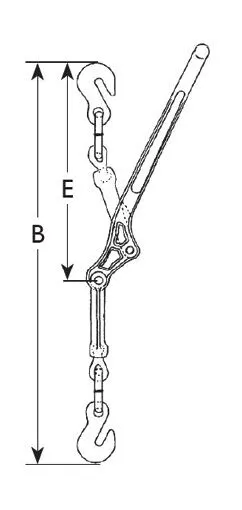How to use a Load Binder?
How to use a Load Binder | Ask the Experts
Last week on the Hercules SLR Blog we talked about the different types of load binders and choosing the best for the job, and now that we know how to choose a load binder, it’s time to learn how to use a load binder!
If you missed last week’s blog (you can check it out here), a load binder, or chain binder, is a tool used to tighten a chain when securing a load for transportation. There are two basic types of load binders – lever binders and ratchet binders. The difference between the two is right in the name, describing the method for tightening.
Load binders are valuable construction tools, however, there are safety hazards that may arise with their misuse. When you use a load binder, users must be trained in the selection, use and inspection cautions to personnel, environmental effects, all applicable standards, regulations & practices. The content of today’s blog will include basic guidelines and tips & tricks when using load binders but does not replace proper training.
How to use a Load Binder – Regulations
Depending on the type of load, size of the load, and type of vehicle used for transport their are many variant requirements in both the US & Canada set by the Department of transportation. Users must be knowledgeable and properly trained on the requirements specific to their circumstances before transporting loads in North America.
Generally, ALL vehicles weighing 10,000lbs or more MUST be secured & tied down at a minimum of all 4 corners, and vehicles below 10,000lbs do not require corner tie-downs.
When calculating the minimum number of load binders and anchor points needed for a load, you have to take into consideration the length, weight, and type of cargo. A good rule of thumb is when you add the working load limits (WLL) of all load binders they must equal at least 50% of the weight of the cargo. Though keep in mind, if the WLL of your chain is less than the load binders, your WLL must be reduced to that of the chain.
Beyond this, some general regulations to keep in mind when using load binders are the following (though always double-check for a location or industry-specific regulations):
- Cargo that weighs less than 1,100 lbs and is under 5′ only requires one load binder
- Cargo that is over 1,100 lbs and is under 5′ requires 2 load binders
- Cargo that is between 5′ and 10′ require 2 load binders
- Cargo exceeding 10′ requires an additional load binder for each additional 10′ or part there of (2 for 10′, 3′ for 10′-20′, 4 for 20′ -30′ etc.)
- Cargo prevented from forward movement by a bulkhead or another load requires a load binder for every 10′ and for each 10′ or part thereof.
- Indirect load binders (across or through the load from one side of the trailer to the other side) should form a minimum angle of 30 degrees to the trailer floor.
- Wheeled or tracked vehicles over 10,000 Lbs require a minimum of 4 Anchor (Direct) load binders, each with a minimum working load limit of 5,000 Lbs.
If your cargo has accessory attachments such as booms, shovels or backhoes they must be lowered and properly secured, often with additional load binders. Steel coils, paper rolls, concrete pipe, dressed lumber, boulders, flattened cars, automobiles, light trucks, vans, and containers require special calculations. Always follow Transportation Canada’s Cargo Securement Rules regarding special applications, general load securement practices, and out of service criteria.
How to use a Load Binder – Ratchet Type
Step 1: Turn the pawl to the neutral position so that it is disengaged from the binder gears.
Step 2: Use your hand to unscrew and fully extend the binder hooks ensuring you do not exceed the maximum extension length.
Step 3: With your binding chain connected to the load at approximately a 45-degree angle, attach the hooks to the chain while taking up as much slack as possible. Assure it’s in a position that will allow you to operate it while standing on the ground and get in a position with a secure footing. Be aware of ice, snow, rain, oil, etc. that can affect your footing.
Step 4: Turn the pawl to the “in” setting and begin ratcheting the chain to the desired tension needed.
Step 5: Wrap any remaining chain around the binder handle and secure the loose end.
To remove and release: Turn the pawl to the “out” setting and begin ratcheting the binder until the chain becomes slack and the binder hooks can be removed easily from the chain.
*You should routinely lubricate the pawl and screw threads of ratchet binders to extend product life and reduce friction wear. Before each use, always check for wear, bending, cracks, nicks, or gouges. If bending or cracks are present – Do not use the load binder and contact us! Our experts can assist in inspection, maintenance, and if necessary, replacement.

How to use a Load Binder – Lever Type
Step 1: Hook the load binder to the binding chain, taking up as much slack as possible. Assure it’s in a position that will allow you to operate it while standing on the ground and get in a position with a secure footing. Be aware of ice, snow, rain, oil, etc. that can affect your footing.
Step 2: Position the load binder so the handle is faced in a position to be pulled down. If sufficient leverage cannot be obtained, a ratchet type load binder should be used instead.
Step 3: With your arms fully extended, use two hands to grab the top of the binder handle and pull the handle back until it has completely closed and sets in place. Be sure to check the load binder handle to be sure it is in the locked position and that the bottom side touches the chain link. This step may need to be repeated if the binding chain is not at the desired tension.
Step 4: Wrap any remaining chain around the binder handle and secure the loose end.
To remove and release: With an open hand, slowly pull upwards on the binder handle until the tension has been released and remove the load binder from the binding chain. When doing this, remember there is a great deal of energy in the stretched chain and this will cause the load binder handle to move very quickly and with great force when it is unlatched. Always move the handle with caution and keep your body out of the path of the moving handle/chain as it may whip.
*You should routinely lubricate the pivot and swivel points of lever binders to extend product life and reduce friction wear. Before each use, always check for wear, bending, cracks, nicks, or gouges. If bending or cracks are present – Do not use the load binder and contact us! Our experts can assist in inspection, maintenance, and if necessary, replacement.
WARNING – Improper use of a Load Binder Can Result in Serious Injury or Death
- Do not operate the load binder while you or anyone else is on the load.
- When applying the binder, always position the load binder so the handle is tightened in a downward manner. Failure to do so may result in a sudden snapping back of the lever, which might result in serious injury or death.
- Load binders are designed to be tightened to the approximate Working Load Limit by a substantial hand effort.
- Do not use a handle extension. They can severely damage the load binder system and result in serious injury or death.
- The operator should at all times use the load binder from a firm standing position that will ensure protection for himself as well as those in the immediate vicinity.
- Load binders are a form of machinery and require periodic inspection and maintenance.
- Inspect for wear, deformation, cracks, nicks, or gouges before using. Replace if damaged. Load binders should be periodically lubricated to give optimum performance and reduce friction losses.
——————————————————————————————————————————————
The Hercules Group of Companies encompasses a wide portfolio of products and services across 7 diverse companies.


